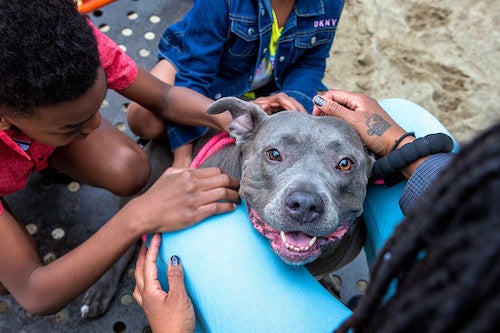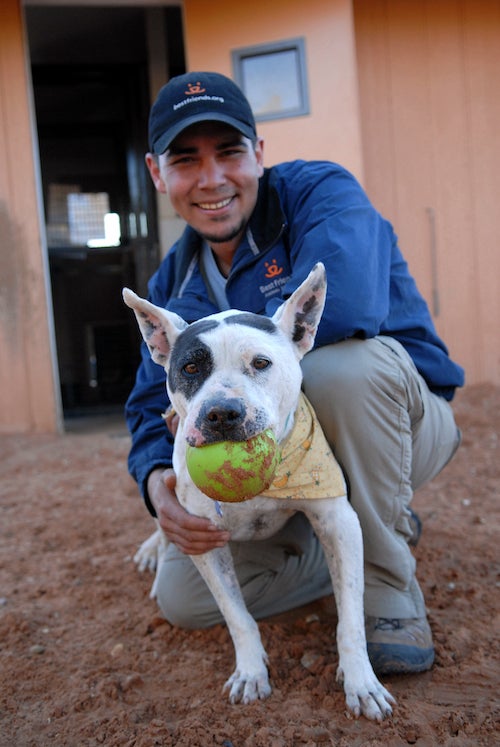
Is your messaging successfully communicating your organization’s DEI focus?
The year 2020 was pivotal in many ways. There was COVID, of course, with all its subsequent disruptions. And then there was what National Public Radio (NPR) dubbed "the Summer of Racial Reckoning,” when “George Floyd, Breonna Taylor and Ahmaud Arbery all became part of a rallying cry in cities and towns across the country, forcing the United States to confront the racism of its past and present.”
Animal welfare likewise felt compelled to examine the field’s overwhelmingly white representation through the lens of diversity, equity, and inclusion (DEI). At Best Friends, that meant incorporating DEI into our mission-critical strategies and business plans, as well as creating multicultural resources. Staff from throughout the organization are volunteering on six culture councils to make recommendations to top leadership on everything from our internal culture and hiring practices to how we make decisions, communicate and promote our work via marketing materials.

Whether we are talking about social media postings advertising adoption events, fundraising documents for potential donors, or trap-neuter-vaccinate-return (TNVR) door hangers, every piece of collateral should speak to the diverse audience we are trying to both serve and attract. But as Jose Ocano said in an earlier program spotlight on this topic, “DEI is not just about putting a person of color on your collateral; that can’t be where it starts and ends.” So, what is it, then?
Last July, we invited representatives from the branding firm Mission Minded to speak about this very topic at the Best Friends National Conference (BFNC). Judging by the standing-room-only crowd at “Shift the Narrative: Reframing Messaging for Equity and Impact” with Abbey Meyers, senior strategist and manager of communications, and Tierney Yates, DEI advisor, organizations of all kinds are hungry for guidance.
“I didn’t know what I was walking into, but I was met with such a welcome,” says Tierney, who is also the founder of Little Light Consulting Firm.
As I was walking the halls after the session, at least 30 people came up to me and said, ‘This conversation is so needed, and you need to come back again next year.’ That really made me feel like this was exactly where I needed to be.
Seven guiding questions
No matter the industry, Mission Minded’s advice to organizations about how to make sure their messaging is as authentic, inclusive, and anti-racist as possible is structured around seven guiding questions.
“We find that when a lot of organizations look at their current messaging, they see that it’s coming from a deficit-based place,” Tierney says, noting that when he used to work in fundraising, he didn’t understand why so many groups use phrases like “at-risk” to describe the communities they serve. “People don’t have control over the neighborhood they were born into; schools don’t get a choice of the property taxes in their community. Those are systemic inequities that we are putting on people.”
While putting out materials seeking donations to help a school in an at-risk community may succeed in attracting funding from a certain segment of the population, it does little to involve those community members in solving their own issues. And Tierney notes that although organizations tend to look at their habits of using deficit-based scenarios and say, ‘we’re terrible,’ he reassures them that the first step toward inclusivity is being willing to evaluate what they have been doing through a new lens.
“That’s why I call these questions and not checkpoints,” Tierney explains. “They are designed to spark internal conversation about what the organization’s messaging conveys."
Ultimately, these questions are designed to allow people to create messaging and write amazing stories in a way that uplifts the community they want to talk about
1. Are you using person-first language?
Just as it’s easy to lump people into groups like those “at-risk” communities mentioned above, it’s also easy to fall into the habit of labeling people by their experiences.

This “subconsciously begins to reduce them to that single experience, creating a narrow–or even worse–a stereotypical view” of them, says Mission Minded in its blog post “7 Questions To Make Your Messaging More Inclusive.” “You’re able to create true connection when you acknowledge that these individuals are people and that circumstances happen, most often as a result of systemic inequities.”
Consider the difference between saying that someone is homeless versus saying someone is experiencing homelessness. Being without a home is a transitory state brought about by certain life circumstances. It’s “fixable,” for lack of a better term, and thus shouldn’t be used to define someone wholly.
2. Are your actions “with” or “for”?
In this field, it’s not unusual for organizations to say things like, “We are fighting for the rights of marginalized communities to have access to reasonably priced veterinary care.” Or we are going to “meet people where they’re at.”
Statements like these create an imbalance of power and reinforce a “savior” narrative. The same goes for saying things like, “we are educating people about responsible pet ownership.”
It implies that whoever the target community is, they suffer from a lack of knowledge about how to take care of their cats and dogs but that we will gladly teach them how to do so
“Instead of saying that we are educating others, we need to recognize that we are providing educational opportunities for one another,” Tierney says. “Collaborate is my favorite word for what we are doing. After all, there are things your organization knows work and there are things that the community you are trying to serve know that work. We need to bring those together to create real solutions.”
As you’re drafting messages, Tierney suggests asking yourself the following:
- Where is my organization being positioned compared to those we are talking about?
- Is my organization being seen as above, below or side-by-side?
Now rephrase your original messaging to talk about how your organization pairs, collaborates and aligns with the community in ways that increase inclusion and equity.
3. Are you using asset-based framing?
 Contrary to using terms that are deficit-based, asset-based framing focuses first on individual or community aspirations and then discusses challenges as “details that come up as part of the journey, not as immediate limitations to what they can accomplish.”
Contrary to using terms that are deficit-based, asset-based framing focuses first on individual or community aspirations and then discusses challenges as “details that come up as part of the journey, not as immediate limitations to what they can accomplish.”
According to Mission Minded, this guiding question is especially important to ask when trying to show organizational impact. After all, those are the times when nonprofits tell stories stressing how they overcame the challenges faced by a community.
“These types of stories diminish agency from those they serve and can reinforce characterizations of dependency and dehumanization,” Tierney says.
4. Have you challenged expectations?
“All of us hold conscious and unconscious biases, especially towards communities that have been historically marginalized,” Tierney explains, noting that such biases have a tendency to seep into our stories and visual messaging. As a result, we just create more materials that perpetuate stereotypes and negative perceptions.
If we can (instead) create stories around positive representation, showing limitless possibilities of what individuals and communities aspire to achieve, we will begin to see perception shifts
5. Have you named the thing?

If he could share only one piece of advice with organizations seeking to incorporate DEI into their work, it would be this: Name the thing.
“Most of the time these are not individual problems, but symptoms of greater systemic inequities,” Tierney says. “Naming those social, economic and political inequities opens the door to better understanding, solutions and empathy for those who have been hurt by these systems. Once we name the things that don’t serve us, once we bring them out into the open and communicate about them, then we can collaborate on dismantling those things and creating new mechanisms in their place.”
6. Have you acknowledged the reality of people from various racial and ethnic backgrounds?
Not only are people more than simply their experiences (as question #1 pointed out), but people are also capable of experiencing privilege and oppression simultaneously through a myriad of ways. This is known as intersectionality.
“If you are a Black woman who identifies as queer, you will experience a completely different kind of repression than a white man who has a disability,” Tierney says.
Honoring the differences allows people to be seen for who they are as an individual rather than as a category
“Once you recognize that your organization’s services and programs do impact people differently, this will allow you to tell stories in an authentic way through their voices while also prioritizing their identity,” he adds. “It’s important that the lived experience of those you serve is acknowledged and uplifted.”
7. Is this your story to tell?
Without question, the stories of people and animals receiving support from an organization’s resources are powerful motivators. If we want to truly be inclusive, however, we need to ask:
- Who should tell the story?
- Do we have consent to use the story? Can that consent be retracted?
- Is the consent informed (where and how it will be used)?
- Can the story subject change or edit the story?
- Have we offered compensation for the story?
As Tierney notes in his blog, “Actively using these guiding questions does make the writing process longer, but this is the time and care that inclusive messaging requires from all of us. This is the work. It is continuous, and we are always learning. And your brand and messaging will get stronger and stronger the more you lean authentically into these practices.”

Liz Finch
Senior Writer
Best Friends Network
If you enjoyed this program spotlight, you can find our complete catalog of spotlights here.